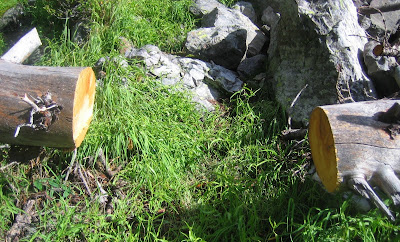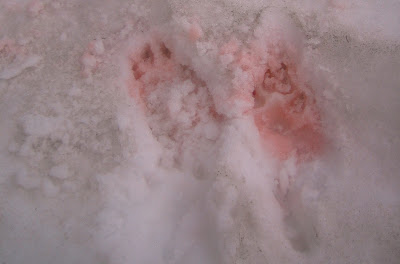From the truck we hiked a mile or so up to the summit:
This is just one of several sites that are part of Martha's work on the GLORIA project--Global Observation Research Initiative in Alpine Environments (thinking up cool acronyms is crucial to scientifice research!). With monitoring sites all over the world, GLORIA is an incredibly important international effort to figure out how increasing carbon dioxide (CO2) levels are changing climate. Here's a map of GLORIA sites around the world:
Martha likes the fact that she can look out her office window and see this site high on Mount Fleecer, south of Butte, Montana. There it is, just ahead of us:
Just below the summit, you can see from the gnarled Whitebark Pine trees what a windy place this is. The trees, like many Whitebarks across the Northern Rockies, are dying from blister rust and pine beetle attacks:
Once at the main site, we walked to each of the four quadrant (N, S, E, W) sites, laid out a grid:
And then Martha documents the plants growing within it. Later, she will enter this data into the international database and make seasonal comparisons from year-to-year to correlate climate change with vegetation shifts. There is a soil temperature recorder buried at each site as well:
Oh yeah--first rule of GLORIA fieldwork: DO NOT tangle up the grid. Martha left Bablu & I alone with it for a few minutes, and we quickly found ourselves in a game of cat's cradle:
We were chatting a lot and did not spot any big mammals (elk, mule deer, and mountain goats all live in the area), but we did see a few pikas and a lot of gray jays and other local residents. Hmmm, looks like Bear lives here too (dried, well-aged turd from last year):
Bear has been visiting recently, according to this over-turned rock on a corner of one of the grids:
Here's one of the smaller animals that was common at the site:
Although the lower elevation woodlands and prairies have dried out in the summer heat and lack of rain, it is still lush at 9,000 feet:
It was educational to be afield with a trained ecologist and botanist. Martha pointed out the Crytptogramic Crust and explained the role it plays in holding soils togehter against the forces of erosion:
She also pointed out some flower species new to me, including Spotted Saxifrage (Saxifraga bronchialis):
And Northern Gentian (Gentianella amarella probably, though it could also be one of several very similar species; Martha took a sample for a more positive identification at a later time):
The humble bees were busy trying to make the most of the last few days of summer, as this bee on a False Dandelion (Agoseris glauca):
The lupines are still in prime bloom, like this Bigleaf Lupine (Lupinus polyphyllus probably -- as a botanist, Martha is the first to point out how subtle differences and easy hybridization make plant species identification very tricky). These late bloomers probably won't set seed before the frosty nights of Fall set in:
The Little-flowered Pensemon (Penstemon procerus) were also lighting up the mountainside:
Even the fungi are still thriving at this high, wet site (probably a Bolete):
With a cold front moving in, we were lucky to have some sunny moments and only a little light sleet & rain on this late-August day. As the first of September (and Labor Day!) approaches, I would not be surprised to wake some morning to a little snow in my yard back in Walkerville.
-----------------------------------------------------------------------------------------------
For more information, see:
GLORIA in North America: an Alpine Ecology Monitoring Network











































































